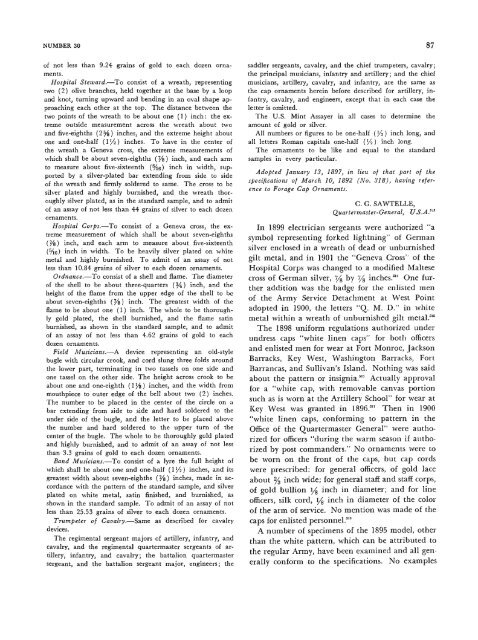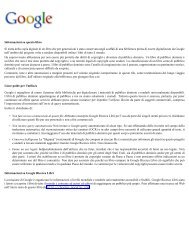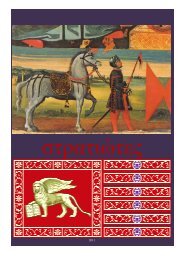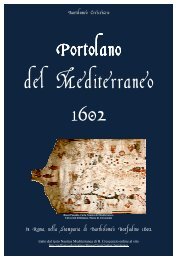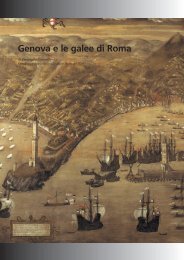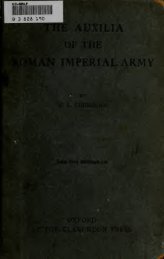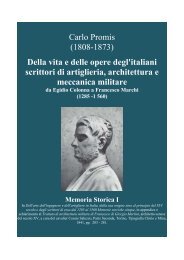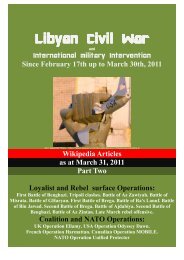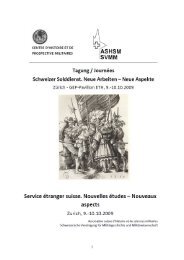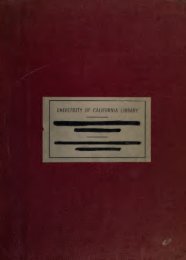86SMITHSONIAN STUDIES IN HISTORY AND TECHNOLOGYIn 1896 a distinct improvement was made in thecomposition of the cap ornaments. Where theyhad been die struck from sheet brass and fastenedto the cap by means of wires soldered to the reverse,they were now to be struck from solid brass andattached by means of a brass screw with washer andnut.'''' This being the first really comprehensivedescription of a group of headgear insignia, thespecifications are included below.WAR DEPARTMENT,QUARTERMASTER-GENERAL'S OFFICE.Specifications for Cap Ornaments.Material.—The devices to be made of solid bronze, struckin one piece, by sharp keen dies, free from all imperfections.The numbers and letters are also to be struck from solidbronze and attached to the device by means of hard solder,the number above and the letter below, except where otherwisedesignated, supported on the back by an extra pieceof bronze also hard soldered to the device. At the back ofeach device there shall be an attachment, to connect thedevice with the body of the cap, consisting of a brassthreadedpost, about one-half (/a) inch long, over whichis passed a brass washer about five-sixteenth (%G) inch indiameter, and the whole attachment made secure to thecap by a thumbscrew about one-half (Y2) inch in diameter,concave, and a hollow threaded post about one-quarter (54)inch deep, in the center, to fit over the threaded post abovedescribed.All ornaments to be shaped so as to fit the oval surfaceof the cap, and to have soldered to the backs thereof two(2) sharp needle points about three-sixteenth (%G) inchlong, for the purpose of holding the ornaments securely inposition on the cap.Infantry Device.—To consist of two (2) rifles crossingeach other at a point equidistant from the butts and muzzles,the muzzles pointing upward and the hammers upward.Length of rifle about two and five-eighths (2^) inches;distance • between the extreme points of the muzzles abouttwo and one-quarter {2Yi) inches, and between the buttsabout two (2) inches. All to be thoroughly gold plated andburnished, and to admit of an assay of not less than 4.84grains of gold to each dozen ornaments.Artillery.—To consist of two (2) cannons crossing eachother at the trunnions, muzzles upward; length of cannonsabout two and one-eighth (2^/8) inches; distance betweenthe muzzles about one and seven-sixteenths (1%6) inches,and between the cascabels about one and seven-eighths{IYB) inches. All to be thoroughly gold plated and burnished,and to admit of an assay of not less than 5.06 grainsof gold to each dozen ornaments.Cavalry.—To consist of two (2) sabers crossing eachother at the center, representing two cavalry sabers inscabbards, with hilts and edges upward. The extreme distancebetween the guards to be about two and three-eighths(2%) inches, and between the points of the scabbardsabout two and three-eighths {2Ys) inches. Each ornamentto be thoroughly gold plated and burnished, and to admitof an assay of not less than 3.52 grains of gold to eachdozen ornaments.Engineers.—To consist of a castle, representing an ancientcastle with three towers. The height of the center tower tobe about seven-eighths {Ya) inch; side towers about oneand one-eighth {lYs) inches; battlements between towersabout five-eighths {Ys) inch; width at base about one andsix-eighths (1%) inches: at top of side towers about one andthree-quarters (1%) inches. The letter to be attached tothe top of the center tower. The whole to be thoroughlygold plated, satin finished, and burnished, as shown in thestandard sample, and to admit of an assay of not less than10.03 grains of gold to each dozen ornaments.Post Quartermaster Sergeant.—To consist of a wreathrepresendng two (2) olive branches, held together at thebase by a loop and knot, turning upward and bending in anoval shape approaching each other at the top. The distancebetween the two points of the wreath to be about one (1)inch; the extreme outside measurement across the wreathabout two and five-eighths (2^4) inches; extreme heightabout one and one-half (1 /a) inches. To have in the centerof the wreath a silver-plated key and quill pen, crossingeach other and supported by a silver-plated bar extendingfrom side to side of the wreath; the key, quill pen, and barto be silver plated on white metal, and hard soldered to thewreath. The wreath to be thoroughly gold plated, satinfinished, and burnished, as shown in the standard sample,and to admit of an assay of not less than 9.24 grains ofgold to each dozen ornaments.Signal Corps.—To consist of a wreath, representing two(2) olive branches, held at the base by a loop or knot,turning upward and bending in an oval shape approachingeach other at the top. The distance between the two pointsof the wreath to be about one (1) inch; the extreme outsidemeasurement across about two and five-eighths {2Ys)inches; and the extreme height to be about one and one-half(I/2) inches. To have in the center of the wreath two (2)crossed signal flags, with a torch in the center standingperpendicularly, all soldered to and resting on a crossbarextending from side to side of the wreath and hard solderedto same. The signal flags, torch, and bar to be silver platedon white metal. The wreath to be thoroughly gold plated,satin finished, and burnished, as shown in the standardsample, and to admit of an assay of not less than 9.24grains of gold to each dozen ornaments.Commissary Sergeant.—To consist of a wreath, representingtwo (2) olive branches, held at the base by a loop andknot, turning upward and bending in an oval shape approachingeach other at the top. The distance between thetwo points of the wreath to be about one (1) inch; the extremeoutside measurement across about two and five-eighths{2Ys) inches, and the extreme height to be about one andone-half (1/2) inches. To have in the center of thewreath a silver-plated crescent, cusps pointing upward,supported by a silver-plated bar extending from side to sideof the wreath, and firmly hard soldered to same; the crescentand bar to be silver plated on white metal. The wreathto be thoroughly gold plated, satin finished, and burnished,as shown in the standard sample, and to admit of an assay
NUMBER 30 87of not less than 9.24 grains of gold to each dozen ornaments.Hospital Steward.—To consist of a wreath, representingtwo (2) olive branches, held together at the base by a loopand knot, turning upward and bending in an oval shape approachingeach other at the top. The distance between thetwo points of the wreath to be about one (1) inch: the extremeoutside measurement across the wreath about twoand five-eighths {2Ys) inches, and the extreme height aboutone and one-half (1 J/a) inches. To have in the center ofthe wreath a Geneva cross, the extreme measurements ofwhich shall be about seven-eighths (Ys) inch, and each armto measure about five-sixteenth (%6) inch in width, supportedby a silver-plated bar extending from side to sideof the wreath and firmly soldered to same. The cross to besilver plated and highly burnished, and the wreath thoroughlysilver plated, as in the standard sample, and to admitof an assay of not less than 44 grains of silver to each dozenornaments.Hospital Corps.—To consist of a Geneva cross, the extrememeasurement of which shall be about seven-eighths( YB ) inch, and each arm to measure about five-sixteenth(%o) inch in width. To be heavily silver plated on whitemetal and highly burnished. To admit of an assay of notless than 10.84 grains of silver to each dozen ornaments.Ordnance.—To consist of a shell and flame. The diameterof the shell to be about three-quarters (Yi) inch, and theheight of the flame from the upper edge of the shell to beabout seven-eighths (Ys) inch. The greatest width of theflame to be about one (1) inch. The whole to be thoroughlygold plated, the shell burnished, and the flame satinburnished, as shown in the standard sample, and to admitof an assay of not less than 4.62 grains of gold to eachdozen ornaments.Field Musicians.—A device representing an old-stylebugle with circular crook, and cord slung three folds aroundthe lower part, terminating in two tassels on one side andone tassel on the other side. The height across crook to beabout one and one-eighth {lYs) inches, and the width frommouthpiece to outer edge of the bell about two (2) inches.The number to be placed in the center of the circle on abar extending from side to side and hard soldered to theunder side of the bugle, and the letter to be placed abovethe number and hard soldered to the upper turn of thecenter of the bugle. The whole to be thoroughly gold platedand highly burnished, and to admit of an assay of not lessthan 3.3 grains of gold to each dozen ornaments.Band Musicians.—To consist of a lyre the full height ofwhich shall be about one and one-half (1 /a) inches, and itsgreatest width about seven-eighths (Ys) inches, made in accordancewith the pattern of the standard sample, and silverplated on white metal, satin finished, and burnished, asshown in the standard sample. To admit of an assay of notless than 25.53 grains of silver to each dozen ornaments.Trumpeter of Cavalry.—Same as described for cavalrydevices.The regimental sergeant majors of artillery, infantry, andcavalry, and the regimental quartermaster sergeants of artillery,infantry, and cavalry; the battalion quartermastersergeant, and the battalion sergeant major, engineers; thesaddler sergeants, cavalry, and the chief trumpeters, cavalry;the principal musicians, infantry and artillery; and the chiefmusicians, artillery, cavalry, and infantry, are the same asthe cap ornaments herein before described for artillery, infantry,cavalry, and engineers, except that in each case theletter is omitted.The U.S. Mint Assayer in all cases to determine theamount of gold or silver.All numbers or figures to be one-half (Y2) inch long, andall letters Roman capitals one-half ('/a) inch long.The ornaments to be like and equal to the standardsamples in every particular.Adopted January 13, 1897, in lieu of that part of thespecifications of March 10, 1892 (No. 318), having referenceto Forage Cap Ornaments.C. G. SAWTELLE,Quartermaster-General, U.S.A.'"In 1899 electrician sergeants were authorized "asymbol representing forked lightning" of Germansilver enclosed in a wreath of dead or unburnishedgilt metal, and in 1901 the "Geneva Cross'' of theHospital Corps was changed to a modified Maltesecross of German silver, Yghy y^ inches."" One furtheraddition was the badge for the enlisted menof the <strong>Army</strong> Service Detachment at West Pointadopted in 1900, the letters "Q. M. D." in whitemetal within a wreath of unburnished gilt metal.''"'The 1898 uniform regulations authorized underundress caps "white linen caps" for both officersand enlisted men for wear at Fort Monroe, JacksonBarracks, Key West, Washington Barracks, FortBarrancas, and Sullivan's Island. Nothing was saidabout the pattern or insignia.'"" Actually approvalfor a "white cap, with removable canvas portionsuch as is worn at the Artillery School" for wear atKey West was granted in 1896.''" Then in 1900"white linen caps, conforming to pattern in theOffice of the Quartermaster General" were authorizedfor officers "during the warm season if authorizedby post commanders." No ornaments were tobe worn on the front of the caps, but cap cordswere prescribed: for general officers, of gold laceabout % inch wide; for general staff and staff corps,of gold bullion i/^ inch in diameter; and for lineofficers, silk cord, i/^ inch in diameter of the colorof the arm of service. No mention was made of thecaps for enlisted personnel."'*A number of specimens of the 1895 model, otherthan the white pattern, which can be attributed tothe regular <strong>Army</strong>, have been examined and all generallyconform to the specifications. No examples
- Page 1:
• ^ - :lP-'L^ry\'^ ^iT
- Page 4 and 5:
ABSTRACTHowell, Edgar M. United Sta
- Page 7 and 8:
ContentsPagePrefaceiiiThe 1855 Cava
- Page 9 and 10:
United States Army Headgear 1855-19
- Page 11 and 12:
NUMBER 30report, stated: "The hat p
- Page 13 and 14:
NUMBER 30acorns %g inches long and
- Page 15 and 16:
NUMBER 30the pattern." The rate of
- Page 17 and 18:
NUMBER 30FIGURE 3.—1858 Army hat.
- Page 19 and 20:
NUMBER 3011model, number 60 in the
- Page 21 and 22:
NUMBER 30 13"the desired modificati
- Page 23 and 24:
NUMBER 30 15the sun in the top. The
- Page 25 and 26:
NUMBER 30 17FIGURE 8.—1858 forage
- Page 27 and 28:
NUMBER 30 19Hardtack and Coffee, ca
- Page 29 and 30:
NUMBER 3021FIGURE 11.—a, Brigadie
- Page 31 and 32:
NUMBER 30 23short "shell" jacket "f
- Page 33 and 34:
NUMBER 30 26broad, securely soldere
- Page 35 and 36:
NUMBER 30 27worn in the picture wer
- Page 37 and 38:
NUMBER 30 29This communication elic
- Page 39 and 40:
NUMBER 30 31FIGURE 17.—"The [Scot
- Page 41 and 42:
NUMBER 30 33time for issue in the c
- Page 43 and 44: NUMBER 30 35be at too great a dista
- Page 45 and 46: NUMBER 3037half (5/2) part of washb
- Page 47 and 48: NUMBER 30 39trimmings for all enlis
- Page 49 and 50: NUMBER 30 41ing the upper space for
- Page 51 and 52: NUMBER 30rear one to a correspondin
- Page 53 and 54: NUMBER 30 46FIGURE 29.—1872 enlis
- Page 55 and 56: NUMBER 3047FIGURE 32.—^The Bent &
- Page 57 and 58: NUMBER 3049of strong split-leather
- Page 59 and 60: NUMBER 30 51''""MttfenFIGURE 35.—
- Page 61 and 62: NUMBER 30 53(which he thought might
- Page 63 and 64: NUMBER 30 55FIGURE 38.—Captain Be
- Page 65 and 66: NUMBER 30 57campaign hat for the Ar
- Page 67 and 68: NUMBER 30 59salvage something from
- Page 69 and 70: NUMBER 30 61hat. In June 1899 the P
- Page 71 and 72: NUMBER 3063the left side, pass diag
- Page 73 and 74: NUMBER 30 65.LJU^.."*^..FIGURE 44.
- Page 75 and 76: NUMBER 30 67to be sent to Washingto
- Page 77 and 78: NUMBER 30 69with brass sliding-buck
- Page 79 and 80: NUMBER 30 71FIGURE 48.—Officers'
- Page 81 and 82: NUMBER 3073The adoption of the whit
- Page 83 and 84: NUMBER 3075i >•^\Wiii I ifiiiniim
- Page 85 and 86: NUMBER 30this last model made no pr
- Page 87 and 88: NUMBER 30 79WAR DEPARTMENT,QUARTERM
- Page 89 and 90: NUMBER 3081FIGURE 58.—1864 chapea
- Page 91 and 92: NUMBER 30geon 1880 and Surgeon Gene
- Page 93: NUMBER 3085FIGURE 63.—1895 forage
- Page 97 and 98: AppendixMAKERS OF HEADGEARThe chron
- Page 99 and 100: List of AbbreviationsAAGAAQMAGAGOAQ
- Page 101 and 102: NUMBER 3093all OQMG, LS, Clothing,
- Page 103 and 104: NUMBER 30 95"Jesup to Thomas, 8 Dec
- Page 105 and 106: NUMBER 3097OQMG, Reg. LR, Clothing,
- Page 107 and 108: NUMBER 30 99October of 1870. See Me
- Page 109 and 110: NUMBER 30 101'"* See above, pp. 35-
- Page 111 and 112: NUMBER 30 103Monroe, Va., in 1878.
- Page 113 and 114: NUMBER 30 105""Endorsement, 24 May
- Page 115 and 116: ReferencesThe bulk of the source ma
- Page 117: M MBIiR 30 10910, No. 355-10, 19 Se


